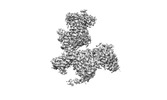Entry Database : EMDB / ID : EMD-33562Title Cryo-EM structure of human k-opioid receptor-Gi complex Complex : KOR Gi ComplexComplex : Guanine nucleotide-binding protein, KOR, scFv16Protein or peptide : Guanine nucleotide-binding protein G(i) subunit alpha-1Protein or peptide : Kappa-type opioid receptorProtein or peptide : Guanine nucleotide-binding protein G(I)/G(S)/G(T) subunit beta-1Protein or peptide : Guanine nucleotide-binding protein G(I)/G(S)/G(O) subunit gamma-2Protein or peptide : scFv16Complex : DynorphinProtein or peptide : Dynorphin / / Function / homology Function Domain/homology Component
/ / / / / / / / / / / / / / / / / / / / / / / / / / / / / / / / / / / / / / / / / / / / / / / / / / / / / / / / / / / / / / / / / / / / / / / / / / / / / / / / / / / / / / / / / / / / / / / / / / / / / / / / / / / / / / / / / / / / / / / / / / / / / / / / / / / / / / / / / / / / / / / / / / / / / / / / / Biological species Homo sapiens (human)Method / / Resolution : 3.3 Å Chen BO / Xu FE Funding support Organization Grant number Country National Natural Science Foundation of China (NSFC)
Journal : Protein Cell / Year : 2023Title : Cryo-EM structure of human κ-opioid receptor-Gi complex bound to an endogenous agonist dynorphin A.Authors : Yuxiang Chen / Bo Chen / Tingting Wu / Fangfang Zhou / Fei Xu / History Deposition Jun 8, 2022 - Header (metadata) release May 24, 2023 - Map release May 24, 2023 - Update Jul 2, 2025 - Current status Jul 2, 2025 Processing site : PDBj / Status : Released
Show all Show less
 Open data
Open data Basic information
Basic information
 Map data
Map data Sample
Sample Keywords
Keywords Function and homology information
Function and homology information Homo sapiens (human)
Homo sapiens (human) Authors
Authors China, 1 items
China, 1 items  Citation
Citation Journal: Protein Cell / Year: 2023
Journal: Protein Cell / Year: 2023
 Structure visualization
Structure visualization Downloads & links
Downloads & links emd_33562.map.gz
emd_33562.map.gz EMDB map data format
EMDB map data format emd-33562-v30.xml
emd-33562-v30.xml emd-33562.xml
emd-33562.xml EMDB header
EMDB header emd_33562_fsc.xml
emd_33562_fsc.xml FSC data file
FSC data file emd_33562.png
emd_33562.png emd-33562.cif.gz
emd-33562.cif.gz emd_33562_half_map_1.map.gz
emd_33562_half_map_1.map.gz emd_33562_half_map_2.map.gz
emd_33562_half_map_2.map.gz http://ftp.pdbj.org/pub/emdb/structures/EMD-33562
http://ftp.pdbj.org/pub/emdb/structures/EMD-33562 ftp://ftp.pdbj.org/pub/emdb/structures/EMD-33562
ftp://ftp.pdbj.org/pub/emdb/structures/EMD-33562 emd_33562_validation.pdf.gz
emd_33562_validation.pdf.gz EMDB validaton report
EMDB validaton report emd_33562_full_validation.pdf.gz
emd_33562_full_validation.pdf.gz emd_33562_validation.xml.gz
emd_33562_validation.xml.gz emd_33562_validation.cif.gz
emd_33562_validation.cif.gz https://ftp.pdbj.org/pub/emdb/validation_reports/EMD-33562
https://ftp.pdbj.org/pub/emdb/validation_reports/EMD-33562 ftp://ftp.pdbj.org/pub/emdb/validation_reports/EMD-33562
ftp://ftp.pdbj.org/pub/emdb/validation_reports/EMD-33562
 F&H Search
F&H Search Links
Links EMDB (EBI/PDBe) /
EMDB (EBI/PDBe) /  EMDataResource
EMDataResource Map
Map Download / File: emd_33562.map.gz / Format: CCP4 / Size: 52.7 MB / Type: IMAGE STORED AS FLOATING POINT NUMBER (4 BYTES)
Download / File: emd_33562.map.gz / Format: CCP4 / Size: 52.7 MB / Type: IMAGE STORED AS FLOATING POINT NUMBER (4 BYTES) Sample components
Sample components Homo sapiens (human)
Homo sapiens (human) Homo sapiens (human)
Homo sapiens (human) Homo sapiens (human)
Homo sapiens (human)
 Homo sapiens (human)
Homo sapiens (human) Homo sapiens (human)
Homo sapiens (human)
 Homo sapiens (human)
Homo sapiens (human)
 Homo sapiens (human)
Homo sapiens (human)
 Homo sapiens (human)
Homo sapiens (human)
 Processing
Processing Sample preparation
Sample preparation Electron microscopy
Electron microscopy FIELD EMISSION GUN
FIELD EMISSION GUN
 Movie
Movie Controller
Controller



































 Z (Sec.)
Z (Sec.) Y (Row.)
Y (Row.) X (Col.)
X (Col.)





































